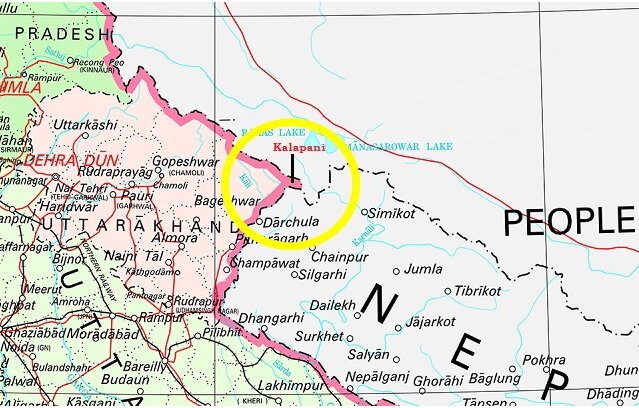International Relations
The Big Picture: Downturn In Indo-Nepal Relations
- 02 Jul 2020
- 6 min read
Nepal’s government, after going through the serious internal rift and the Chinese assistance regarding the same have tabled a crucial Constitution Amendment bill to formalise the country’s controversial new map which claims parts of India as its territory.
- The Bill is to formalise the country’s new map claiming the Indian territory of Lipulekh, Kalapani and other areas as its territory.
- Nepal’s map is a part of its national emblem, hence, there is a requirement for the constitutional amendment.
- India’s contention is that Nepal raised the dispute at the “behest of an external force”, namely China as with so much integration with India & open borders over the years, raising boundary demarcation issues seem unjustified.
Cause of the Dispute
- The dispute is primarily due to the varying interpretation of the origin of the river Kali and its various tributaries that slice through the mountains of Limpiyadhura.
- The Kalapani region derives its name from the river Kali. Nepal’s claims to the region is based on this river as it became the marker of the boundary of the kingdom of Nepal following the Treaty of Sugauli.
- Nepal claims that the land mass, high in the mountains that falls to the east of the entire stretch starting from Limpiyadhura downwards, belongs to them.
- India on the other hand says the border begins at Kalapani as this is where the river begins.
Treaty of Sugauli
- Treaty of Sagauli, (March 4, 1816), was an agreement between the Gurkha chiefs of Nepal and the British Indian government that ended the Anglo-Nepalese (Gurkha) War (1814–16).
- By the treaty, Nepal renounced all claim to the disputed Tarai, or lowland country, and ceded its conquests west of the Kali river and extending to the Sutlej river.
- Nepal remained independent, but it received a British resident with the status of an ambassador to an independent country rather than of the controlling agent of the supreme government in an Indian state.
Significance of Nepal For India
- Nepal shares borders with 5 Indian states- Uttarakhand, Uttar Pradesh, West Bengal, Sikkim and Bihar. Hence, is an important point of cultural and economic exchange.
- Nepal is right in the middle of India’s ‘Himalayan frontiers’, and along with Bhutan it acts as northern ‘borderland’ flanks and acts as a buffer against any possible aggression from China.
- Rivers originating in Nepal feed the perennial river systems of India in terms of ecology and hydropower potential.
- Many Hindu and Buddhist religious sites are in Nepal making it an important pilgrimage site for a large number of Indians
- The India-Nepal Treaty of Peace and Friendship of 1950 forms the bedrock of the special relations that exist between India and Nepal.
- The two countries not only share an open border and unhindered movement of people, but they also have close bonds through marriages and familial ties, popularly known as Roti-Beti ka Rishta.
Treaty of Peace and Friendship of 1950
- The treaty talks about reciprocal treatment of Indian and Nepali citizens in the two countries, in residence, property, business and movement.
- It also establishes national treatment for both Indian and Nepalese businesses (ie once imported, foreign goods would be treated no differently than domestic goods).
- It also gives Nepal access to weaponry from India.
China’s Intervention
- As a landlocked nation, Nepal depended for many years on Indian imports, and India played an active role in Nepal's affairs.
- However, in recent years Nepal has drifted away from India's influence, and China has gradually filled the space with investments, aid and loans.
- China considers Nepal a key partner in its Belt and Road Initiative (BRI), and wants to invest in Nepal's infrastructure as part of its grand plans to boost global trade.
- Rising Nepal and China cooperation can undermine Nepal’s distinction of buffer state between India and China.
- China on the other hand wants to avoid the formation of any Anti-China stance by the Tibetans living in Nepal.
Way Forward
- India should negotiate diplomatically to resolve the boundary dispute with Nepal under the aegis of International law on Trans-boundary Water Disputes. In this case, boundary dispute resolution between India and Bangladesh should serve as a model for this.
- India needs to take steps inthe right direction, to resolve the border issues before the constitution gets amended.
- India should engage more proactively with Nepal in terms of people to people engagement, bureaucratic engagement as well as political interactions.
Read more: TTP on India-Nepal Relations







